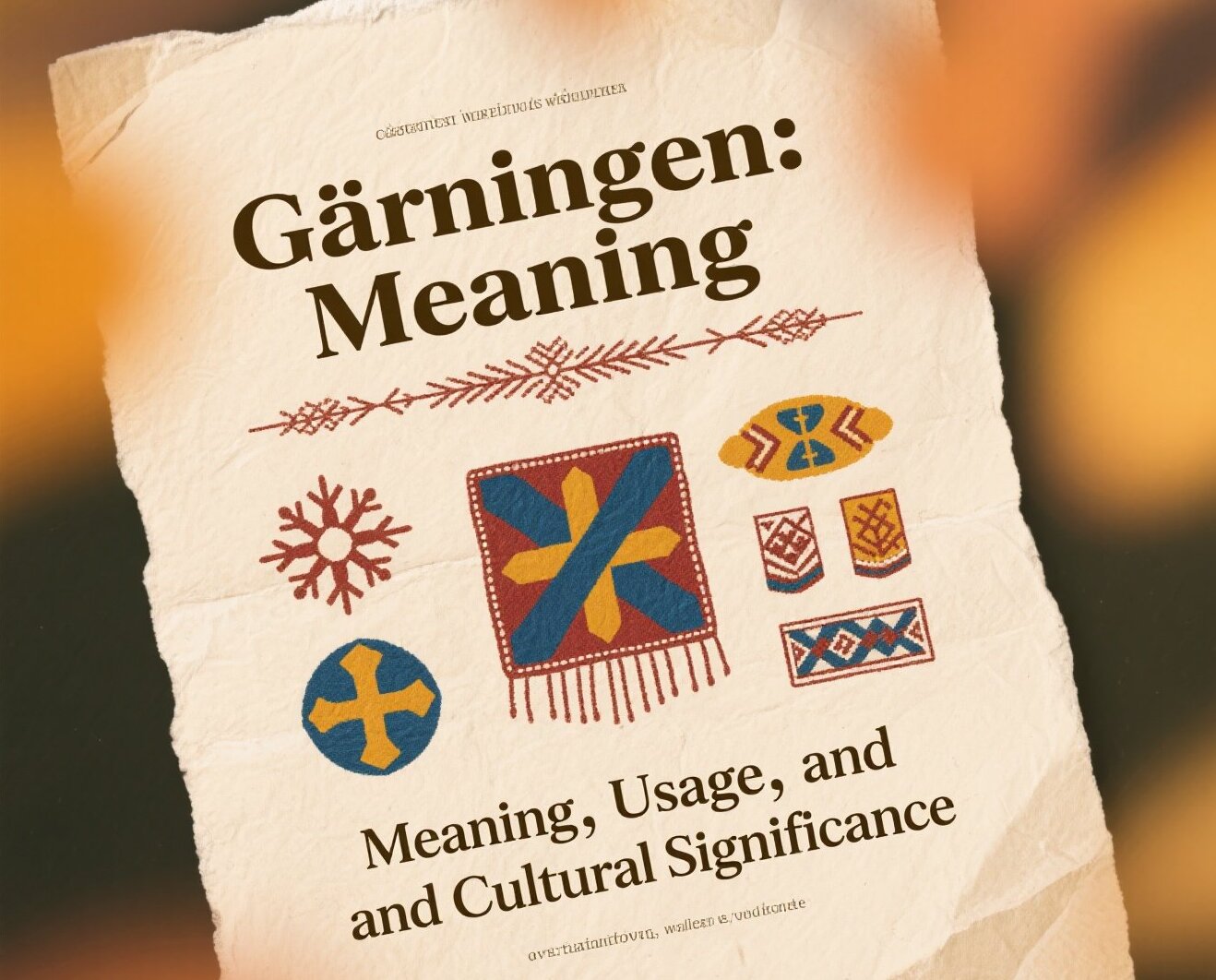Introduction to the Word Gärningen
The Swedish word “gärningen” translates directly to “the act” or “the deed” in English. At first glance, it may appear to be a simple noun, but in reality, it carries significant cultural, linguistic, and legal weight in Sweden and other Swedish-speaking regions. It is a word deeply tied to action, responsibility, and consequence, making it essential in contexts ranging from everyday conversation to crime reporting and literature.
In everyday Swedish, “gärningen” can describe both good deeds and negative acts. For example, a charitable act might be called a god gärning (a good deed), while in a criminal setting, gärningen often refers to an unlawful act or crime. Because of this duality, it plays a unique role in shaping how Swedes describe and evaluate human behavior.
The purpose of this article is to break down the different dimensions of this powerful word. We will explore its meaning, grammatical structure, etymology, and its role in law, literature, and media. By doing so, readers—whether language learners, cultural enthusiasts, or fans of Nordic noir—can better understand why “gärningen” is more than just a translation of the act. It is a linguistic mirror reflecting Sweden’s values of justice, accountability, and narrative storytelling.
Understanding the Meaning of Gärningen
At its core, “gärningen” is the definite singular form of the noun gärning, which means act or deed. Grammatically, this means it refers to “the act” rather than just “an act.” This distinction may seem subtle but is crucial in Swedish, where definite forms often imply specificity and importance.
In Swedish society, gärningen can be used in two broad contexts: positive and negative. In positive contexts, it may describe good deeds, acts of kindness, or heroic efforts. For example, a charitable volunteer’s work could be described as a god gärning. On the other hand, in legal and crime-related contexts, it often points to unlawful or harmful actions. A common phrase, “Han greps på bar gärning,” translates to “He was caught in the act,” almost always referring to a criminal act.
This dual meaning gives the word flexibility and power. It is not limited to one sphere of life but can describe everything from moral choices to legal evidence. In discourse, it helps shape narratives around accountability—whether praising an honorable action or condemning a wrongful deed. In short, gärningen is a word that embodies human action in its most consequential form.
Etymology and Linguistic Background
The word gärningen originates from the Swedish verb göra, meaning to do. By adding the suffix -ning, the action is transformed into a noun, much like “do” becomes “doing” in English. The process reflects how Swedish often constructs nouns from verbs, linking the concept of action with its outcome.
From a grammatical standpoint, gärning is a common gender noun in Swedish. Like other nouns, it follows regular patterns of pluralization and definite forms:
- en gärning – an act
- gärningen – the act
- gärningar – acts
- gärningarna – the acts
This structure makes it an accessible word for Swedish learners because its usage is consistent across linguistic contexts.
The etymology also highlights the cultural emphasis on action. By deriving the word from to do, Swedish ties the concept of gärning directly to human behavior and agency. Every gärning reflects something that was done—intentionally or not—and therefore carries consequenc. This is why the word is so prevalent not only in everyday speech but also in law, ethics, and storytelling.
For linguists, gärningen is a prime example of how language captures cultural attitudes. In Sweden, where justice and social responsibility are central values, the very structure of the word reflects an enduring connection between deed and consequence.
Legal Use of Gärningen in Sweden
Common in Crime and Justice Reporting
In Sweden, the word gärningen is central to legal language and crime reporting. It appears frequently in police reports, court proceedings, and media headlines because it provides a neutral but powerful way to describe a criminal act. Journalists and investigators often use phrases like:
- Tidpunkten för gärningen – The time of the act
- Platsen för gärningen – The place of the act
- Motivet bakom gärningen – The motive behind the act
These expressions form the backbone of investigative narratives, helping authorities and the public understand not only what happened but also why and how. When someone is “på bar gärning” (caught red-hand), the word itself emphasizes the immediacy and evidence of the crime.
Importance in Legal Definitions
In Swedish criminal law, gärningen is more than just a description—it is a legal determinant. Courts must establish whether an act was intentional (uppsåtlig gärning) or negligent (oaktsam gärning). This classification directly influences the severity of sentencing and the perception of guilt.
For instance, striking someone by accident and causing injury may be classified as a negligent act, whereas planning and carrying out an assault is an intentional act. Both are gärningar, but their legal and moral weight differs drastically.
This shows how the Swedish legal system places great emphasis on intent, context, and consequence. Without the concept of gärningen, it would be difficult to frame these distinctions with clarity.
Gärningen in Literature and Storytelling
Beyond the courtroom, gärningen plays a symbolic and thematic role in Swedish literature, particularly in crime fiction and Nordic noir. In this genre, the word often stands at the center of suspense-driven narratives, representing the crime that must be solve or the dark deed haunting a character’s past.
Authors use gärningen not only to describe literal acts but also to explore moral and psychological conflicts. A mysterious gärning can drive an entire plot, keeping readers engaged as they search for answers about what happened, who did it, and why. In thrillers and historical fiction, the word can also symbolize pivotal turning points, representing deeds that forever alter a character’s fate.
Nordic noir, a globally popular genre, often uses gärningen as the focal point of the story. Whether in novels or screen adaptations, the gärning often embodies societal critique, revealing the tension between individual responsibility and systemic failures.
In this way, the word transcends its grammatical meaning to become a literary device, helping authors convey suspense, moral ambiguity, and emotional weight.
Modern Media and Popular Culture
In modern Swedish media, gärningen continues to hold strong relevance. It is commonly use in TV series, documentaries, and true crime shows, where acts of crime are dissect in detail. Titles such as I gärningens spår (“In the footsteps of the act”) reflect this cultural fascination with tracing actions back to their roots.
The prevalence of the term in documentary titles, episode scripts, and narrations reinforces its association with investigative storytelling. Audiences instantly recognize it as a reference to crucial actions that need explanation or justice.
True crime journalism, in particular, relies heavily on gärningen. Reporters use it as a narrative anchor, guiding viewers through the sequence of events. The neutrality of the term allows it to describe acts without prematurely judging them, which is essential in maintaining journalistic credibility.
As a result, gärningen has moved beyond the courtroom and novels to become a cornerstone of fact-based storytelling in Swedish culture. Its repeated presence in popular media ensures that even those with limited knowledge of the Swedish language recognize its meaning and significance.
International Understanding of Gärningen
Although gärningen is a Swedish term, it has gained international recognition through the global success of Scandinavian crime dramas and literature. Viewers of Nordic noir series often encounter it in subtitles or hear it in dialogues, gradually familiarizing themselves with its meaning.
Translated works also preserve the term in certain contexts, especially when there is no direct English equivalent that captures both the neutrality and gravity of the word. For example, while the act is a common translation, it lacks the cultural resonance that gärningen carries in Sweden.
Academic fields such as linguistics, law, and cultural studies have also taken interest in the term. Scholars analyze how gärningen reflects Sweden’s legal framework and societal values, making it a case study in the intersection between language and justice.
In this way, gärningen has crossed cultural and linguistic borders. It represents not only an action but also the Scandinavian approach to responsibility, intent, and consequence—a perspective that continues to intrigue international audiences.
Conclusion: Why Gärningen Matters
The word “gärningen” is far more than just a direct translation of the act. It embodies Sweden’s cultural emphasis on action, accountability, and consequence. Whether use in legal settings, literature, or popular media, it shapes how actions are understood, judged, and narrate.
In law, it determines guilt and punishment. In literature, it creates suspense and moral conflict. I media, it anchors true crime storytelling. And internationally, it offers insights into how language reflects societal values.
For Swedish learners, understanding gärningen opens the door to mastering not only grammar but also cultural nuance. supporting fans of Nordic noir, it enhances the experience of decoding plots rooted in crime and morality. For scholars, it serves as a linguistic lens into Sweden’s justice system and storytelling traditions.
Ultimately, gärningen is a reminder that words are never just words. They carry layers of meaning that reflect the societies that use them. By exploring gärningen, we gain a deeper appreciation of how one term can embody law, culture, and narrative all at once.











Leave a Reply